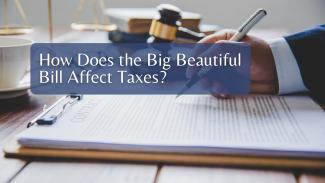
OBBBA: Clean Energy Credits, Business Perks, and What’s Sunsetting Soon
Last Call for These Tax Breaks (And a Few You May Not Know About) ~ Clean Energy, Bonus Depreciation, QSBS & More
To wrap up our series on the One Big Beautiful Bill Act (OBBBA), here’s a roundup of notable (but less headline-grabbing) provisions — including some time-sensitive ones you may want to act on before year-end.
Clean Energy Tax Credits Are Being Cut Short
Several Inflation Reduction Act credits are ending earlier than planned:
• EV credit: Ends for vehicles purchased after September 30, 2025 (we noted this one in our first post to give you a few more weeks to shop)
• Home energy upgrades (windows, heat pumps, etc.): Ends December 31, 2025
• Solar & clean energy installations: 30% credit ends after December 31, 2025
📌 Deadlines: These all require purchase — and in some cases installation — by year-end 2025.
💡Planning Tip: If you’re considering a major energy upgrade, act now — these won’t roll over.
Business Owners: Some Big Wins
• Bonus Depreciation: 100% expensing is permanently restored for eligible property placed in service after January 19, 2025
• Section 179 Limits: Increased to $2.5M per property and $4M aggregate, with inflation indexing starting in 2025
• R&D Expenses: U.S.-based research costs can now be fully expensed retroactively for 2021–2024
📌 Reminder: If you plan to place qualifying assets into service this year, ensure they meet the post-January 19, 2025 service date.
Qualified Small Business Stock (QSBS)
• Section 1202 capital gain exclusion limit increases from $10M to $15M for stock acquired after July 4, 2025
• Also introduces partial exclusions:
o 50% if held 3–4 years
o 75% if held 4–5 years
o 100% after 5 years
What hasn’t changed: QSBS treatment only applies to businesses that were formed as C corporations and requires very specific ownership conditions.
Qualified Opportunity Zones (QOZ): Rebooted
• Created by the Tax Cuts and Jobs Act of 2017, pooled funds investing in QOZs offered significant tax benefits by deferring and potentially reducing or eliminating capital gains tax liability from prior investments. These zones were defined as low income geographic areas.
• New round of QOZ designations begins in 2026 in a more permanent version than in TCJA but with narrower definitions of “low income” and less interim basis step-ups.
• Capital gains can again be deferred starting in 2027 if reinvested in new Qualified Opportunity Funds (QOFs).
• Enhanced incentives for QOZ’s investing 90% of funds in rural investments include a 30% basis step-up.
A Few More Notables:
• Adoption Credit: Now partially refundable up to $5,000 and inflation-adjusted
• Child & Dependent Care Credit: Higher applicable percentages for low- and middle-income families
• 1099 Reporting Thresholds: Back to $20K and 200 transactions for 1099-Ks for third party payment processors (good news for online sellers)
• 1% Tax on Overseas Remittances: Applies to most international money transfers
Final Thoughts:
OBBBA brings both complexity and opportunity — and many of the most valuable strategies involve timing income, deductions, and credits to take full advantage of phase-ins and phaseouts.
If you're unsure how to prioritize year-end moves or align these changes with your broader plan, we’re always here to help and work with your tax advisor to find the best tax strategy for you.
Thank you for following along with our OBBBA series. We hope it’s been helpful!

